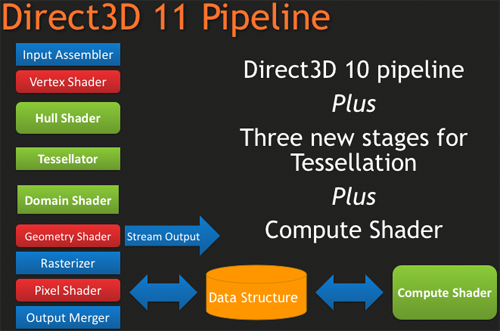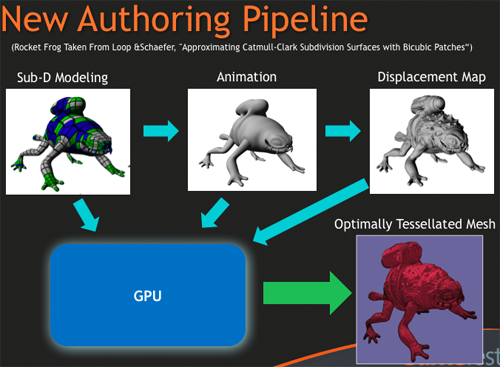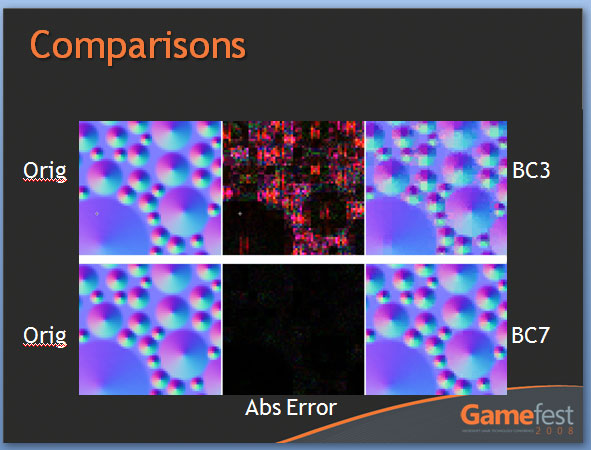AMD's Radeon HD 5870: Bringing About the Next Generation Of GPUs
by Ryan Smith on September 23, 2009 9:00 AM EST- Posted in
- GPUs
DirectX11 Redux
With the launch of the 5800 series, AMD is quite proud of the position they’re in. They have a DX11 card launching a month before DX11 is dropped on to consumers in the form of Win7, and the slower timing of NVIDIA means that AMD has had silicon ready far sooner. This puts AMD in the position of Cypress being the de facto hardware implementation of DX11, a situation that is helpful for the company in the long term as game development will need to begin on solely their hardware (and programmed against AMD’s advantages and quirks) until such a time that NVIDIA’s hardware is ready. This is not a position that AMD has enjoyed since 2002 with the Radeon 9700 and DirectX 9.0, as DirectX 10 was anchored by NVIDIA due in large part to AMD’s late hardware.
As we have already covered DirectX 11 in-depth with our first look at the standard nearly a year ago, this is going to be a recap of what DX11 is bringing to the table. If you’d like to get the entire inside story, please see our in-depth DirectX 11 article.
DirectX 11, as we have previously mentioned, is a pure superset of DirectX 10. Rather than being the massive overhaul of DirectX that DX10 was compared to DX9, DX11 builds off of DX10 without throwing away the old ways. The result of this is easy to see in the hardware of the 5870, where as features were added to the Direct3D pipeline, they were added to the RV770 pipeline in its transformation into Cypress.

New to the Direct3D pipeline for DirectX 11 is the tessellation system, which is divided up into 3 parts, and the Computer Shader. Starting at the very top of the tessellation stack, we have the Hull Shader. The Hull Shader is responsible for taking in patches and control points (tessellation directions), to prepare a piece of geometry to be tessellated.
Next up is the tesselator proper, which is a rather significant piece of fixed function hardware. The tesselator’s sole job is to take geometry and to break it up into more complex portions, in effect creating additional geometric detail from where there was none. As setting up geometry at the start of the graphics pipeline is comparatively expensive, this is a very cool hack to get more geometric detail out of an object without the need to fully deal with what amounts to “eye candy” polygons.
As the tesselator is not programmable, it simply tessellates whatever it is fed. This is what makes the Hull Shader so important, as it’s serves as the programmable input side of the tesselator.
Once the tesselator is done, it hands its work off to the Domain Shader, along with the Hull Shader handing off its original inputs to the Domain Shader too. The Domain Shader is responsible for any further manipulations of the tessellated data that need to be made such as applying displacement maps, before passing it along to other parts of the GPU.

The tesselator is very much AMD’s baby in DX11. They’ve been playing with tesselators as early as 2001, only for them to never gain traction on the PC. The tesselator has seen use in the Xbox 360 where the AMD-designed Xenos GPU has one (albeit much simpler than DX11’s), but when that same tesselator was brought over and put in the R600 and successive hardware, it was never used since it was not a part of the DirectX standard. Now that tessellation is finally part of that standard, we should expect to see it picked up and used by a large number of developers. For AMD, it’s vindication for all the work they’ve put into tessellation over the years.
The other big addition to the Direct3D pipeline is the Compute Shader, which allows for programs to access the hardware of a GPU and treat it like a regular data processor rather than a graphical rendering processor. The Compute Shader is open for use by games and non-games alike, although when it’s used outside of the Direct3D pipeline it’s usually referred to as DirectCompute rather than the Compute Shader.
For its use in games, the big thing AMD is pushing right now is Order Independent Transparency, which uses the Compute Shader to sort transparent textures in a single pass so that they are rendered in the correct order. This isn’t something that was previously impossible using other methods (e.g. pixel shaders), but using the Compute Shader is much faster.

Other features finding their way into Direct3D include some significant changes for textures, in the name of improving image quality. Texture sizes are being bumped up to 16K x 16K (that’s a 256MP texture) which for all practical purposes means that textures can be of an unlimited size given that you’ll run out of video memory before being able to utilize such a large texture.
The other change to textures is the addition of two new texture compression schemes, BC6H and BC7. These new texture compression schemes are another one of AMD’s pet projects, as they are the ones to develop them and push for their inclusion in DX11. BC6H is the first texture compression method dedicated for use in compressing HDR textures, which previously compressed very poorly using even less-lossy schemes like BC3/DXT5. It can compress textures at a lossy 6:1 ratio. Meanwhile BC7 is for use with regular textures, and is billed as a replacement for BC3/DXT5. It has the same 3:1 compression ratio for RGB textures.
We’re actually rather excited about these new texture compression schemes, as better ways to compress textures directly leads to better texture quality. Compressing HDR textures allows for larger/better textures due to the space saved, and using BC7 in place of BC3 is an outright quality improvement in the same amount of space, given an appropriate texture. Better compression and tessellation stand to be the biggest benefactors towards improving the base image quality of games by leading to better textures and better geometry.
We had been hoping to supply some examples of these new texture compression methods in action with real textures, but we have not been able to secure the necessary samples in time. In the meantime we have Microsoft’s examples from GameFest 2008, which drive the point home well enough in spite of being synthetic.

Moving beyond the Direct3D pipeline, the next big feature coming in DirectX 11 is better support for multithreading. By allowing multiple threads to simultaneously create resources, manage states, and issue draw commands, it will no longer be necessary to have a single thread do all of this heavy lifting. As this is an optimization focused on better utilizing the CPU, it stands that graphics performance in GPU-limited situations stands to gain little. Rather this is going to help the CPU in CPU-limited situations better utilize the graphics hardware. Technically this feature does not require DX11 hardware support (it’s a high-level construct available for use with DX10/10.1 cards too) but it’s still a significant technology being introduced with DX11.
Last but not least, DX11 is bringing with it High Level Shader Language 5.0, which in turn is bringing several new instructions that are primarily focused on speeding up common tasks, and some new features that make it more C-like. Classes and interfaces will make an appearance here, which will make shader code development easier by allowing for easier segmentation of code. This will go hand-in-hand with dynamic shader linkage, which helps to clean up code by only linking in shader code suitable for the target device, taking the management of that task out of the hands of the coder.










327 Comments
View All Comments
SiliconDoc - Wednesday, September 30, 2009 - link
No, it's the fact you tell LIES, and always in ati's favor, and you got caught, over and over again.That is WHAT HAS HAPPENED.
Now you catch hold of your senses for a moment, and supposedly all the crap you spewed is "ok".
SiliconDoc - Friday, September 25, 2009 - link
Once again, all that matters to YOU, is YOUR games for PC, and ONLY top sellers, and only YOUR OPINION on PhysX.However, after you claimed only 2 games, you went on to bloviate about Havok.
Now you've avoided entirely that issue. Am I to assume, as you have apparently WISHED and thrown about, that HAVOK does not function on NVidia cards? NO QUITE THE CONTRARY !
--
What is REAL, is that NVidia runs Havok AND PhysX just fine, and not only that but ATI DOES NOT.
Now, instead of supporting BOTH, you have singled out your object of HATRED, and spewed your infantile rants, your put downs, your empty comparisons (mere statements), then DEMAND that I show PhysX is worthwhile, with "golden sellers". LOL
It has been 1.5 years or so since Aegia acquisition, and of course, game developers turning anything out in just 6 short months are considered miracle workers.
The real problem oif course for you is ATI does not support PhysX, and when a rouge coder made it happen, NVidia supported him, while ATI came in and crushed the poor fella.
So much for "competition", once again.
Now, I'd demand you show where HAVOK is worthwhile, EXCEPT I'm not the type of person that slams and reams and screams against " a percieved enemy company" just because "my favorite" isn't capable, and in that sense, my favorite IS CAPABLE.
Now, PhysX is awesome, it's great, it's the best there is, and that may or may not change, but as for now, NO OTHER demonstrations (you tube and otherwise) can match it.
That's just a sad fact for you, and with so many maintaining your biased and arrogant demand for anything else, we may have another case of VHS instead of BETA, which of course, you would heartily celebrate, no matter how long it takes to get there.
LOL
Yes, it is funny. It's just hilarious. A few months ago before Mirror's Edge and Anand falling in love with PhysX in it, admittedly, in the article he posted, we had the big screamers whining ZERO.
Well, now a few months later you are whining TWO.
Get ready to whine higher. Yes, you have read about the uptick in support ? LOL
You people are really something.
Oh, I know, CUDA is a big fat zero according to you, too.
(please pass along your thoughts to higher education universities here in the USA, and the federal government national lab research facilites. Thanks)
SiliconDoc - Thursday, September 24, 2009 - link
Yes, another excuse monger. So you basically admit the text is biased, and claim all readers should see the charts and go by those. LOLSo when the text is biased, as you admit, how is it that the rest, the very core of the review is not ? You won't explain that either.
Furthermore, the assumption that competition leads to something better in technology for videocards quicker, fails the basic test that in terms of technology, there is a limit to how fast it proceeds forward, since scientific breakthroughs must come, and often don't come, for instance, new energy technologies, still struggling after decades to make a breakthrough, with endless billions spent, and not much to show for it.
Same here with videocards, there is a LIMIT to the advancement speed, and competition won't be able to exceed that limit.
Furthermore, I NEVER said prices won't be driven down by competition, and you falsely asserted that notion to me.
I DID however say, ATI ALSO IS KNOWN FOR OVERPRICING. (or rather unknown by the red fans, huh, even said by omission to have NOT COMMITTED that "huge sin", that you all blame only Nvidia for doing.)
So you're just WRONG once again.
Begging the other guy to "not argue" then mischaracterizing a conclusion from just one of my statements, ignoring the points made that prove your buddy wrong period, and getting the body of your idea concerning COMPETITION incorrect due to technological and scientific constraints you fail to include, is no way to "argue" at all.
I sure wish there was someone who could take on my points, but so far none of you can. Every time you try, more errors in your thinking are easily exposed.
A MONOPOLY, in let's take for instance, the old OIL BARRONS, was not stagnant, and included major advances in search and extraction, as Standard Oil history clearly testifies to.
Once again, the "pat" cleche' is good for some things ( for instance competing drug stores, for example ), or other such things that don't involve inaccesible technology that has not been INVENTED yet.
The fact that your simpleton attitude failed to note such anomolies, is clearly evidence that once again, thinking "is not reuired" for people like you.
Once again, the rebuttal has failed.
kondor999 - Thursday, September 24, 2009 - link
This is just sad, and I'm no fanboy. I really wanted a 5870, but only with 100% more speed than a GTX285 - not a lousy 33%. Definitely not worth me upgrading, so I guess ATI saved me some money. I'm certain that my 3 GTX280's in Tri-SLI will destroy 2 5870's in CF - although with slightly less compatability (an important advantage for ATI, but not nearly enough).Moricon - Thursday, September 24, 2009 - link
I have been a regular at Tomshardware for a while now, nad keep coming back to Anandtech time and again to read reviews I have already read on other sites, and this one is by far the best I have read so far, (guru3d, toms, firing squad, and many others)The 5870 looks awesome, but from an upgrade point of view, I guess my system will not really benefit from moving on from E7200 @3.8ghz 4gb 1066, HD4870 @850mhz 4400mhz on 1680x1050.
Such a shame that i dont have a larger monitor at the moment or I would have jumped immediately.
Looks like the path is q9550 and 5870 and 1920x1200 monitor or larger to make sense, then might as well go i7, i5, where do you stop..
Well done ATI, well done! But if history follows the Nvidia 3xx chip will be mindblowing compared!
djc208 - Thursday, September 24, 2009 - link
I was most surprised at how far behind the now 2-generation old 3870 is now (at least on these high-end games). Guess my next upgrade (after a SSD) should be a 5850 once the frenzy dies away.JonnyDough - Thursday, September 24, 2009 - link
They could probably use a 1.5 GB card. :(mapesdhs - Wednesday, September 23, 2009 - link
Ryan, any chance you could run Viewperf or other pro-app benchmarks
please? Some professionals use consumer hardware as a cheap way of
obtaining reasonable performance in apps like Maya, 3DS Max, ProE,
etc., so it would most interesting to know how the 5870 behaves when
running such tests, how it compares to Quadro and FireGL cards.
Pro-series boards normally have better performance for ops such as
antialiases lines via different drivers and/or different internal
firmware optimisations. Someday I figure perhaps a consumer card will
be able to match a pro card purely by accident.
Ian.
AmdInside - Wednesday, September 23, 2009 - link
Sorry if this has already been asked but does the 5870 support audio over Display Port? I am holding out for a card that does such a thing. I know it does it for HDMI but also want it to do it for Display Port.VooDooAddict - Wednesday, September 23, 2009 - link
Been waiting for a single gaming class card that can power more then 2 displays for quite some time. (The more then 2 monitors not necessarily for gaming.)The fact that this performs a noticeable bit better then my existing 4870 512MB is a bonus.